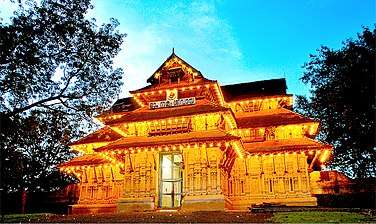Hinduism in Kerala
Hinduism is the largest religion in Kerala and Hindu castes together make up 54.8% of the population of the state according to the 2011 census.



Several saints and movements existed. Adi Shankara was a Hindu philosopher who contributed to Hinduism and propagated philosophy of Advaita. He was instrumental in establishing four mathas at Sringeri, Dwarka, Puri and Jyotirmath. Melpathur Narayana Bhattathiri was another Brahmin religious figure who composed Narayaniyam, a collection of verses in praise of Krishna.
Various practises of Hinduism are unique to Kerala. Different cults of Shiva and Vishnu are popular in Kerala. Lord Krishna is worshipped widely in all parts of Kerala, Guruvayur being one of the most famous temples in the state. Malayali Hindus also worship Bhagavathi as a form of Shakti. Almost every village in Kerala has its own local guardian deity, usually a goddess. Hindus in Kerala also strongly believe in power of snake gods and usually have sacred snake groves known as Sarpa Kavu near to their houses.

Some of the most notable temples are: Guruvayur Temple, Thrissur Vadakkunnathan Temple, Sabarimala Ayyappa Temple, Thiruvananthapuram Padmanabhaswamy Temple, Aranmula Parthasarathy Temple, Chottanikkara Temple, Chengannur Mahadeva Temple, Parassinikadavu Muthappan Temple, Chettikulangara Devi Temple, Mannarasala Temple, Chakkulathukavu Temple, Thiruvalla Sreevallabha Temple, Kaviyoor Mahadevar Temple, Parumala Panayannarkavu Temple, Sree Poornathrayesa Temple, Kodungallur Bhagavathy Temple, and Rajarajeshwara Temple. Temples in Kerala follow elaborate rituals and only priests from the Nambudiri caste can be appointed as priests in major temples. But in 2017 as per the state government's decision, the priests from backward community was appointed. These priests are assisted by a caste known as Ambalavasis.
Malayali Hindus have unique ceremonies such as Chorunu (first feeding of rice to a child) and Vidyāraṃbhaṃ.
Saints
Kerala is home to Hindu saints and swamis of all castes. Vaikunda Swami, who was the first among the saints of Kerala[1] was a Nadar. Bhagavan Sree Narayana Gurudevan, Sant Enadinatha, Sant Ilakkulaccanrar, Sant Tiruppana were all Sudra, Cheraman Nayanar was a Kothayar, Chattampi Swamikal, Swami Sathyananda Saraswathi and Swami Chinmayananda were of the Nair caste, and Adi Shankara was a Nambuthiri Brahmin. The Harijan Parayas of Kerala claim to descend from Sant Vasistha.[2] Kollengode has a structure near Thirthala-Koottanad Road, in memory of a Harijan saint, Sant Paakkanar.[3] In the Rapayan Tujjal, the narrator (dancer-reciter) is a Harijan and a descendant of Sant Pakkanar.[4] The Periya Puranam, possibly written by a Paraya, describes the Parayas. Further, the Vishvakarma Purana was written by a sonar (goldsmith).
Chenkottukonam Madathipathi Jagadguru Swami Sathyananda Saraswathi is popularly regarded as the father of contemporary Hindu renaissance in Kerala for the victorious movements he led for temple rights and the establishment of Hindu Aikya Vedi for integrating Hindus of all classes. He is reckoned as the greatest karmayogi to uphold Sanatana Dharma since Swami Vivekananda internationally.
The official festivals of Sree Narayana Jayanti (Narayana Guru's birthday) and Sree Narayana Samadhi Day (Narayana Guru's death) are celebrated by the Keralites in memory of a great Shudra reformer of their society.
The modern Hindu Karma yogi saint Amma Mata Amritanandamayi was selected to represent Hindu Dharma in the World Parliament of Religions in September 1991.[5] Bhagawan Nityananda is another important Hindu saint recognized worldwide.
Several Hindu movements important to Hindu history took place in Kerala. n Kerala.[6] The Karppillikkavu Sree Mahadeva Temple, (one of the most ancient in India) dedicated to the Kirata Avatar of Lord Shiva still exists in Kerala.
See also
References
| Wikimedia Commons has media related to Hinduism in Kerala. |
- www.education.kerala.gov.in Archived 2008-12-17 at the Wayback Machine Towards Modern Kerala, 10th Standard Text Book, Chapter 9, Page 101. See this Pdf
- Dr. C. I. Issac, "The Origin of Syrian Christians of Keralam"
- P. 94-5Tourist Guide to Kerala: The Land of Lavish Lagoons By V. Subburaj, Various
- (Kr̥ṣṇavāriyar, P. 193 A History of Malayalam Metre)
- "Devotees flock to hug Indian guru" (BBC)